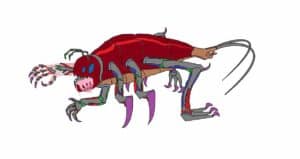Why Does my Cat still have Fleas?
Could your cat have super fleas?
You used a vet recommended product and yet the cat still has live fleas. Logic suggests either the fleas are resistant (super fleas) or the product didn’t work.

Actually the simplest explanation is not super fleas, but that the product was used incorrectly or you had unrealistic expectations about what it could do. Either way, rather than live with the irritation of fleas, when you know how, getting rid of them is only a step away.
Wrong Tools for the Job
Spot ons, sprays, pills, collars…and that’s just the method of administration, let alone the active ingredients. There are a baffling number of flea products on the market, so much choice it’s enough to make your eyes glaze over.
Perhaps your cat has fleas but hates spot-ons and is impossible to pill, so Program injection seemed the best option. However, the cat had the jab a week ago and you’re still suffering from flea bites…Grrr.
This scenario is a good example of the “wrong tool for the job” because Program doesn’t kill adult fleas but sterilizes them. In practical terms this means the adult fleas continue to live a long and happy life, but their eggs are sterile. Thus Program is best suited to preventing a population explosion when a clean pet gets the odd visitor. For a cat with a flea problem the results are disappointing.
The opposite end of the coin is Capstar. This is what’s known as a flea adulticide, in other words it kills adult fleas. Great. Your cat has fleas so you give a Capstar tablet. A pleasing number of fleas drop off stone dead….but then two days later you see more fleas… Grrr.
What happened here is that Capstar is an ultra-fast but ultra-short acting product. It starts killing fleas 15 minutes after giving the pill, but only works for 24 hours. Thus, two days later flea eggs that hatched out overnight jump right onto the clean cat.
To effectively kill fleas means not only selecting the right tool for the job, but also having a basic understanding of the flea life cycle.
The Flea Life Cycle
Here’s an alarming fact: For every one flea you see on the cat, there are another twenty you don’t see. Fleas only feed on the pet, and then hop off to live in the carpet, soft furnishings, and bedding.
Another eye-opener is that each adult flea can lay 50 eggs a day, and it takes just 3 -4 weeks for each egg to hatch out and mature into an adult. Ta dah! A flea population explosion.
One of the reason fleas are such successful parasites is their life cycle. The adult flea feeds on blood, and then hops off the cat to lays eggs in the soft furnishings. Those eggs are protected by a tough shell that can survive a boil cycle on a washing machine. This makes those eggs capable of lying dormant for months or even years, to hatch out when the conditions are right for a new generation of fleas.
What hatches from the egg is a larval form of the flea. The larva’s first meal is…flea dirt…or the dried blood excreted by the adult flea. Thus, the heavier a flea infestation, the more food there is for the next generation. Then the plump, well-fed larva pupates and hatches out into adults. And all this within 3 – 4 weeks…or several years if the eggs need to lie dormant for a while.
The Principles of Flea Control
This means to be a flea killer extraordinaire you must apply a flea adulticide to the cat, treat all the pets in the house (so they don’t act as a reservoir for ship-wrecked fleas) plus use an environmental product (for heavy flea infestations.)
#1: Prevention and Treating a Mild Flea Infestation
If you are fortunate position and have a clean cat that you want to keep that way, one option is a six-monthly injection of Program. As mentioned earlier, this stops fleas breeding so is perfect for keeping a minor problem in check.
For a cat with more than the odd flea, using a flea adulticide is best. These products kill adult fleas and carry on working, usually for one month, at which point they’re reapplied.
End of story? Well, not quite.
If you have more than one cat, it’s important to treat all the pets in the house. This is because fleas will continue their lifecycle feeding off untreated pets.
#2: Treating a Moderate Flea Infestation
Your cat is excessively itchy, you’ve seen the odd flea but haven’t been bitten yourself, you should up the ante treatment wise. Take the steps outlined above, but add in an environmental product to kill the larvae in the carpet and soft furnishings.
These are usually products you spray around the home that work for a number of months. The idea is to kill the next generation in the egg. These environmental products are strong chemicals and must be used with caution, and kept away from reptiles, birds, and fish. It’s best to open the windows and spray one room at a time, leaving it to air for a few hours before returning.
#3: Treating a Severe Flea Infestation
When you’re bitten around the ankles and see live fleas on the pet you have a severe infestation which needs sorting out fast. For maximum benefit, add a rapid knockdown product such as Capstar into the equation. This kills the lives fleas on the pet that day, and gives you a head start in controlling flea numbers. Then proceed with your flea adulticide product and environmental control.
A Word about Natural Remedies
And finally, whilst using natural remedies such as apple cider vinegar or essential oils may seem tempting, there is no evidence to say they are effective. If killing fleas was that simple then the drug companies wouldn’t bother investing millions into research.
However, the following are a useful back up plan to re-inforce your flea control.
Flea comb: Using a flea comb helps remove live fleas but does not to be done daily to be worthwhile.
Vacuum and wash: Daily vacuuming and washing soft furnishings help to physically remove eggs and larvae from the environment.
Diatomaceous earth: Scatter food grade diatomaceous earth on the carpet, leave in 48 hours and then vacuum. Its abrasive nature breaks open flea eggs, causing them to dry out and die.
Flea repellant plants: Lavender, fennel, eucalyptus, and marigold have a mild flea repellant action so plant them in the garden to help keep the environment clean.
And don’t forget, if you’re struggling with a flea problem your vet is best placed to give comprehensive advice about sorting out the problem.
Hopefully,, with all these tips, your cat will be back to their normal antics in no time.

The post Why Does my Cat still have Fleas? appeared first on VetBabble.




Post a Comment